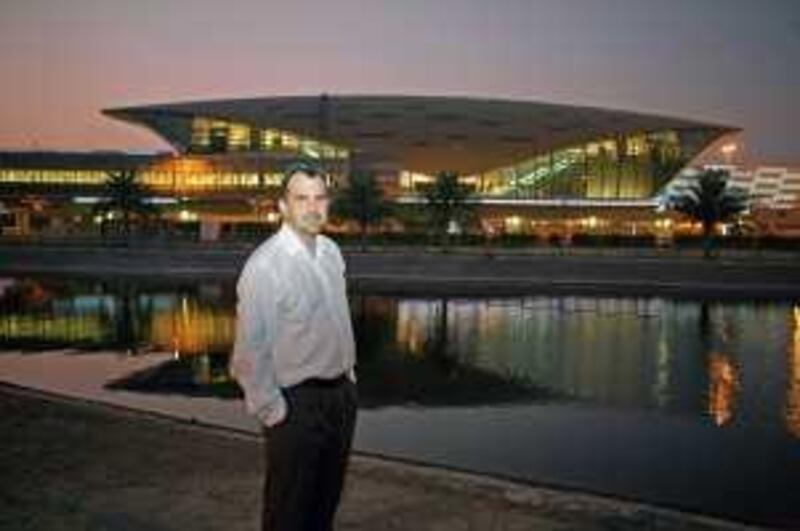The chief designers knew their project would be daunting: the Dubai Metro needed to reflect the city's history and culture, and still be functional and safe. After hundreds of sketches, and four years of construction, the project will finally come to life. Hugh Naylor reports DUBAI // When they took on the project four years ago last month, it became abundantly clear to Boran Agoston and Robert Troup that finding a culturally and aesthetically pleasing design for the Dubai Metro would require a mammoth undertaking.
Even with their combined 60 years of experience, from transport projects in Hong Kong to London, the question of how to gracefully blend such a system into a Middle Eastern metropolis of skyscrapers and sand dunes proved challenging. "There are very few projects like this in the world," said Mr Troup, 45, the managing director for Middle East operations at Aedas, the global architecture firm responsible for designing the Red and Green lines' depots and 47 stations.
"Actually," chimed in Mr Agoston, 50, the company's architectural design director for the project, "there's none like it." One challenge they initially faced was how to design structural meaning into what would become the world's most advanced public-transport system based on what, at the time, seemed like open-ended parameters. "The station architecture shall have an aesthetic form and external appearance which is unique, innovative, iconic and reflecting Dubai's identity and character," read the thrust of requirements given to them by Dubai Municipality in 2005, before the creation of the Roads and Transport Authority, which has since taken over the project.
Yet their team of nearly 100 architects, interior designers and consultants, working around the clock in Dubai and in satellite offices in Birmingham, Hong Kong and Singapore, quickly began revelling in the creative leeway. "On day one, when all you had in front of you was nothing, you were forming ideas; you have hundreds and hundreds of sketches," Mr Agoston said as he displayed a black notebook with charcoal-pencil sketches from the early days.
Some of their proposed designs had stations modelled after falcon wings and dhow sales that, although culturally symbolic, were ultimately rejected. So, too, were impressions that, however interesting they may have seemed during bleary evening brainstorming sessions, bordered on the bizarre, such as stations modelled after fibre optic cable. Despite the occasionally odd creation, Mr Agoston said, the process encouraged the team to dig deep into their creative repertoire.
"You start with a piece of paper playing around, and you're thinking, 'Oh, this is fun'," he said. "Beyond that, you have tonnes - literally tonnes - of papers before you get to the final drawings. Not many people see that. They sometimes say, 'You only have 56 drawings?'" After four years, those drawings have now become tangible, interlocking slabs of concrete and steel columns. And not only did the simple design for the gold and black stations allow for their rapid assembly, they say the symbolism of their sloping, ultra-modern façades remains faithful to UAE heritage.
"The concept, the metaphor behind it, is based on the pearl," Mr Agoston said of the dainty object that was once a staple of the emirate's economy. "We had to make these stations relevant to the city, its history and foundations." KCA International, a UK-based firm contracted out by Aedas to do their interior design, chose a motif of colours and styles for the Red and Green line stations that is intended to symbolise the natural elements of earth, water, air and fire.
"But," Mr Agoston said, "it's not purely a metaphorical exercise. You have to juggle requirements, and at the end of the day it has to be functional and safe, because they're going to be used by millions." That is easier said than done. Everything from ventilation systems and how to get natural light to underground stations, to the shape of the exterior's glass panels for the above-ground ones, had to be carefully scrutinised and altered seemingly countless times.
"To design something like this, you need a standardised panel, without too may shapes so it's easy to construct them," Mr Troup said of the glass exterior of the stations. "It's very rational, pure geometry, done by computers." At times, taking part in a project with a unique hierarchical structure of consultants and engineers required compromise. On some projects, differences over colours and shapes had to be put aside, such as with the 19 footbridges, designed by another company involved in the project.
Regardless of minor aesthetic differences, Messrs Agoston and Troup and their team of designers now feel as if they have left their architectural mark on a bit of history. "To work on a project of this scale and significance," Mr Troup said, "it's great fun." hnaylor@thenational.ae






